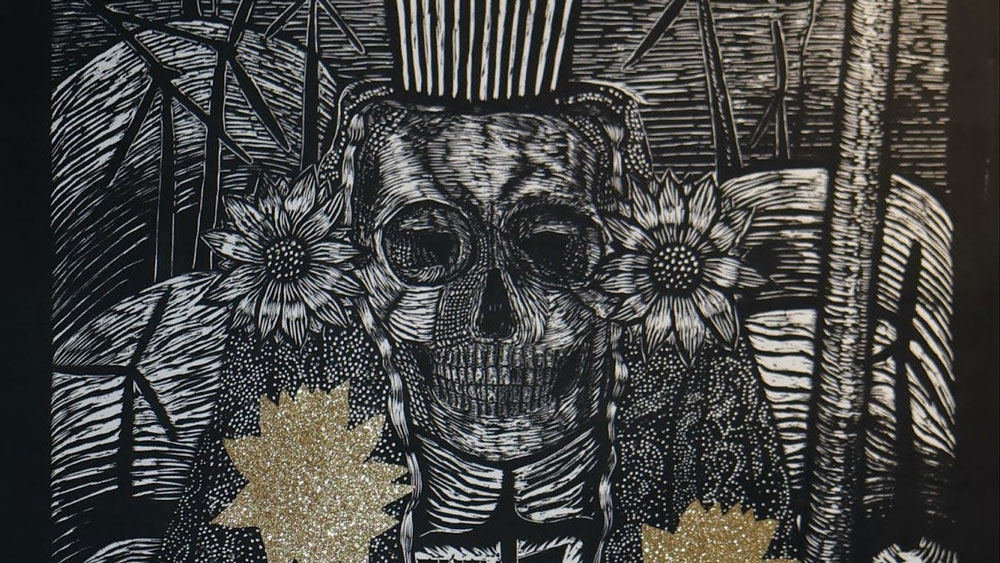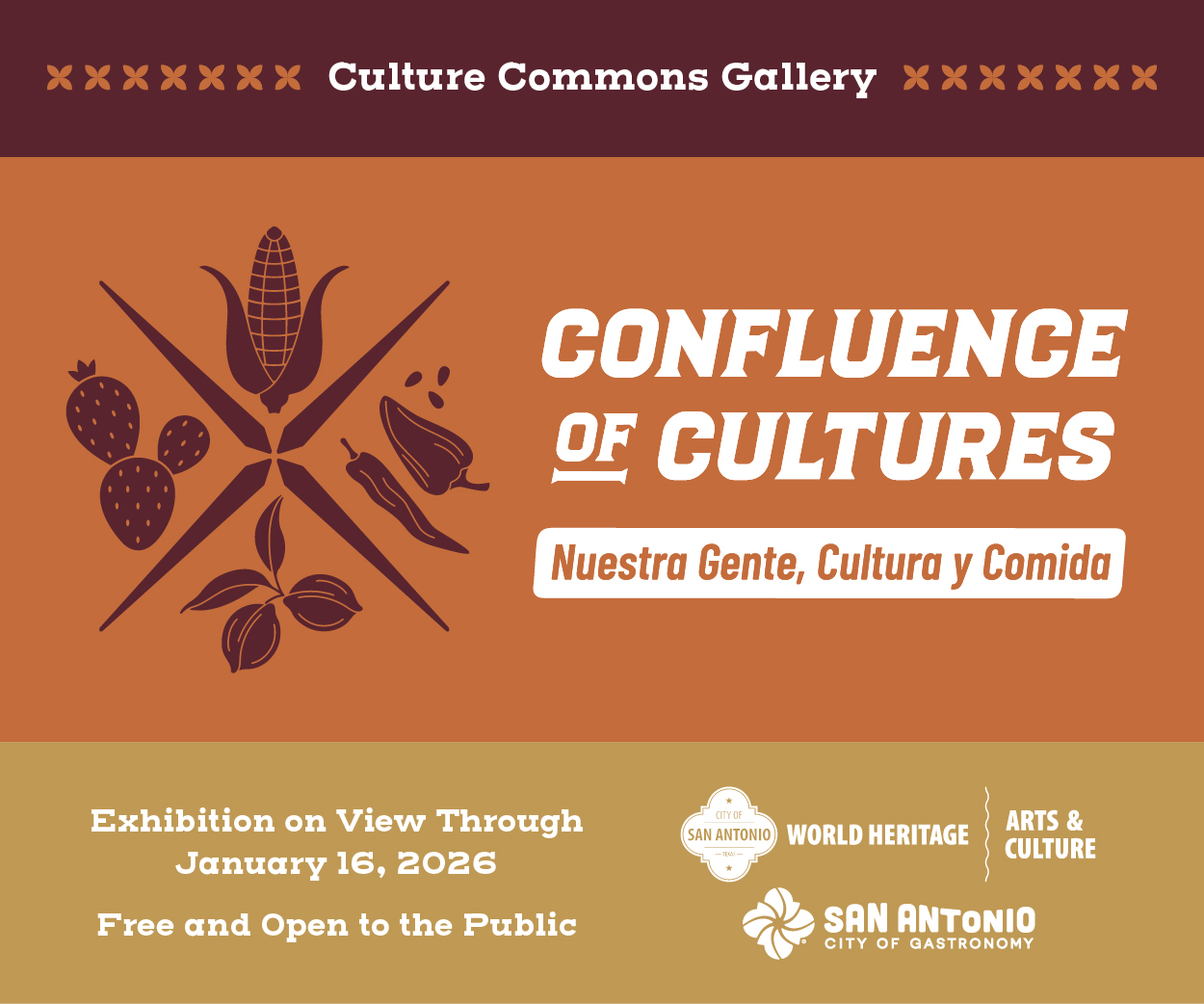An exhibit at the Guadalupe Bookstore in San Antonio’s Westside features works by Celeste de Luna, a highly creative artist and emerging master printer. De Luna’s woodblock and linoleum prints are bold with fanciful and surreal images. In her artist statement, she discusses an interest in exploring “the complexity of relationships and power dynamics between people, animals, domestic spaces, and landscape.”
De Luna grew up in La Feria, Texas, a borderland community six miles from the Rio Grande River. The town is small with fewer than 5,000 residents centrally located midway between McAllen and Brownsville. When de Luna was growing up, La Feria was one of the borderland’s many small communities where agriculture dominated the Rio Grande Valley economy for the first six decades of the 20th century. Living in the Borderlands greatly influenced her outlook and artistic imagination.
Sculptor and artist Ricardo Zamora, a native of La Feria, recalls that the town served as a major hub for processing and shipping farm products in earlier decades. The processing plants and packing sheds burned down years ago, forcing many residents to leave the Valley to seek work elsewhere. The small Anglo population which owned the sheds and controlled the town politics moved to McAllen and Harlingen in the 1960s.
The de Luna family moved to the Midwest in the late 1960s where work was more plentiful. When Celeste de Luna was eight, her family returned to the Rio Grande Valley, settling in La Feria. Although she lamented having almost forgotten her Spanish while in the Midwest, she quickly managed to reconnect with her bilingualism and borderland lifestyle.
After graduating from La Feria High School, de Luna toured several colleges near her home and in San Antonio. When she visited Austin’s St. Edwards University with her aunt, the college recruiters took her to a free music festival at Lake Travis. Country singer Willie Nelson showed up and gave an impromptu performance. The famed country singer and Austin’s laid-back culture impressed de Luna and convinced her to attend the small Catholic university.
After graduating from St. Edwards, de Luna moved back to the Rio Grande Valley and began a teaching career. A presentation by San Antonio artist Joe Lopez at an art education conference in the Valley in 2002 inspired her artistic spirit. It was her first encounter with Chicano art, and the workshop proved transformational. Her high school and university art history classes had never mentioned Latino art. Soon after, De Luna traveled to San Antonio to experience an initial visit to the city’s major “Chicano Gallery,” Lopez’s Gallista Gallery on South Flores.
After several later visits to other San Antonio art galleries and studios, she became familiar with the work of Kingsville Chicana artists Santa Barraza and Carmen Lomas Garza. Learning more about these Chicana artists
inspired her and contributed to her decision to enroll in graduate classes that addressed Chicano art and borderland studies at Pan American University. In 2009, de Luna met two important printmakers from the Midwest, Rene Arceo and Ben Varela. She credits the Midwest printers and Jesus de la Rosa of Kingsville with influencing her printing techniques.
Chicago printer Rene Arceo heads one of the major Latino presses in the U.S. and invited her to become part of a 2010 print portfolio, Centenario de la Revolucion Mexicana [100 Years of the Mexican Revolution]. De Luna chose to design and print the “Adelitas” [women soldiers]. Harriett and I purchased the portfolio of twenty prints in 2010 and donated it to the Benson Latin American Collection at the University of Texas Austin.
After the birth of her second child, de Luna found it difficult to pursue painting because the medium required extended periods of engagement. She discovered greater flexibility in working with wood and linoleum printmaking allowing her to spend more time with her family. In printmaking, de Luna explained, she could start and stop at any time. Printmaking, she added, gave her “a feeling of abundance” in making multiple editions. Printmaking also allowed her to correct mistakes and solve technical problems. De Luna sometimes incorporates fabrics in her collages reminiscent of her mother’s creativity, and using fabric links her artwork to femininity and craft.
A Chicano/Latino Studies journal article published in 2021 includes detailed descriptions of several of de Luna’s prints. Describing one of her best-known images, “Our Lady of the Checkpoint,” de Luna expresses how the artwork represents the anxiety many people feel when approaching an immigration checkpoint. “I see her [Virgin Guadalupe] shimmering in the heat, blinding me with her reflective blanket, emanating barbed wire rays and a razor wire halo around her head.” De Luna added, “…I needed a special Virgin at the checkpoint….She is standing in front of the checkpoint shelter, which becomes her capilla, and the cameras are the all-seeing eyes not of God, but of the government.”
In 2019 de Luna was a Resident Artist at Spudnik Press in Chicago. A press release about her residency noted that de Luna “creates new landscapes and iconographies about women, children, and families at the border, and the spiritual struggle of conflicting identities and ‘survivor’s guilt’ they experience during migration.” The following year she was awarded a Vermont Studio Artist in Residence position. After the Spudnik Studio residency, de Luna and her family moved to San Antonio.
In a recent interview, de Luna expanded on the tensions related to dual-status families when younger children born in the U.S. receive citizenship status and older children who migrated with their parents without legal immigration status are left in limbo. This situation also occurred frequently with the DACA certification for children [Dreamers] when one child arrived in the U.S. at an age that qualified for favorable immigration status and other siblings did not. Many of de Luna’s images capture these complex immigration experiences.
Several years ago de Luna used her savings to buy a large professional printing press. She works with sharp hand-held print-making tools to carve out artistic images on wood or linoleum blocks. She works daily in her large home studio and has leased a gallery space on West Commerce Street where she shows her work.
De Luna’s art has reached audiences beyond Texas. She has gained national exposure from publications that have used her art for illustration. Her print “Necrocitizen” was recently featured on the cover of the book Fencing in Democracy by Miguel Diaz-Barriga and Margaret Dosey published by Duke Press [2020]. De Luna noted that the woodcut “Necrocitizen” depicts the ways various systems of oppression impose second-class citizenship on Brown bodies.
De Luna is an art Instructor at Northwest Vista
College in San Antonio where she teaches art and introductory classes in Mexican American Studies. She has close artistic relations with the Esperanza Peace and Justice Center and frequently volunteers and shows her
work with the Centro Cultural Aztlan. Over the coming year, de Luna plans to expand on historical themes that interest her ranging, from the Indigenous Aztec-Maya period to futuristic and science-fiction concepts. She is making important contributions to the growing Latino art community in San Antonio and beyon
Celeste de Luna: Latina Artist, Printmaker, and Educator






